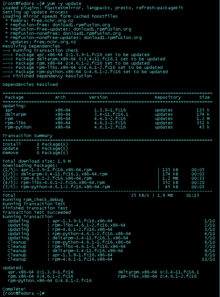Our website is made possible by displaying online advertisements to our visitors.
Please consider supporting us by disabling your ad blocker.
Yum (software)
 YUM running an update on Fedora 16 | |
| Developer(s) | Seth Vidal |
|---|---|
| Initial release | June 2002[1] [2] |
| Stable release | 3.4.3
/ 28 June 2011 |
| Repository | |
| Written in | Python[3] |
| Operating system | Linux, AIX, IBM i, ArcaOS |
| Platform | RPM |
| Type | Package management system |
| License | GPLv2 |
| Website | yum |
The Yellowdog Updater Modified (YUM) is a free and open-source command-line package-management utility for computers running the Linux operating system using the RPM Package Manager.[4] Though YUM has a command-line interface, several other tools provide graphical user interfaces to YUM functionality.
YUM allows for automatic updates and package and dependency management on RPM-based distributions.[5] Like the Advanced Package Tool (APT) from Debian, YUM works with software repositories (collections of packages), which can be accessed locally[6] or over a network connection.
Under the hood, YUM depends on RPM, which is a packaging standard for digital distribution of software, which automatically uses hashes and digital signatures to verify the authorship and integrity of said software; unlike some app stores, which serve a similar function, neither YUM nor RPM provide built-in support for proprietary restrictions on copying of packages by end-users. YUM is implemented as libraries in the Python programming language, with a small set of programs that provide a command-line interface.[7] GUI-based wrappers such as YUM Extender (yumex) also exist,[8] and has been adopted for Fedora Linux until version 22.[9]
A rewrite of YUM named DNF replaced YUM as the default package manager in Fedora 22[9] (in 2015). This was required due to Fedora's transition from Python 2 to Python 3, which is not supported by YUM.[10] DNF also improves on YUM in several ways - improved performance, better resolution of dependency conflicts, and easier integration with other software applications.[11] From RHEL 8, yum is an alias for DNF.[12]
- ^ "Initial Commit". source control message. Seth Vidal. 7 June 2002. Retrieved 17 September 2021.
- ^ "Oldest Mailing List Message". yum mailing list archive. Grigory Bakunov. 11 June 2002. Retrieved 17 September 2021.
- ^ Jang, Michael H. (14 December 2005). "Chapter 7 – Setting Up a YUM Repository". Linux Patch Management: Keeping Linux Systems Up to Date (PDF). Prentice Hall Professional.
- ^ Brown, Robert G. "YUM (Yellowdog Updater, Modified) HOWTO - Introduction". Duke Physics. Retrieved 12 July 2013.
- ^ Shields, Ian (11 May 2010). "RPM and YUM package management". Learn Linux, 101. IBM. Retrieved 12 July 2013.
- ^ "Creating a Local YUM Repository Using an ISO Image". Oracle. Retrieved 12 July 2013.
- ^ Cite error: The named reference
Brownwas invoked but never defined (see the help page). - ^ Cite error: The named reference
yumexwas invoked but never defined (see the help page). - ^ a b Miller, Matthew (11 June 2014). "Board Meeting, Rawhide Rebuilt, Firewall Debate, ARM 64, and DNF as Yum Replacement (5tFTW 2014-06-10)". Fedora Magazine. Retrieved 4 May 2016.
- ^ Wallen, Jack (2015-07-02). "What You Need to Know About Fedora's Switch From Yum to DNF". Linux.com. Retrieved 2021-09-26.
- ^ Edge, Jake (2014-01-15). "DNF and Yum in Fedora". LWN.net. Retrieved 2018-10-16.
- ^ Matteson, Scott (2019-03-30). "What's new with Red Hat Enterprise Linux 8 and Red Hat Virtualization". TechRepublic. Retrieved 2019-09-24.
Previous Page Next Page


